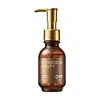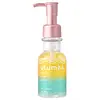What's inside
What's inside
 Key Ingredients
Key Ingredients

 Benefits
Benefits

 Concerns
Concerns

 Ingredients Side-by-side
Ingredients Side-by-side

Cyclopentasiloxane
EmollientDimethicone
EmollientDimethiconol
EmollientTriethylhexanoin
MaskingHydrogenated Polyisobutene
EmollientIsopropyl Myristate
EmollientArgania Spinosa Kernel Oil
EmollientGamma-Docosalactone
Skin ConditioningMeadowfoam Delta-Lactone
Skin ConditioningButyrospermum Parkii Butter
Skin ConditioningIsostearoyl Hydrolyzed Keratin
CleansingPolyquaternium-64
Sodium Lauroyl Glutamate
Opuntia Ficus-Indica Seed Oil
EmollientRosa Centifolia Flower Oil
MaskingCamellia Japonica Seed Oil
EmollientMacadamia Integrifolia Seed Oil
Skin ConditioningPlukenetia Volubilis Seed Oil
EmollientHydrolyzed Keratin
HumectantIsostearoyl Hydrolyzed Silk
Skin ConditioningCeramide Ng
Skin ConditioningCeramide NP
Skin ConditioningCeramide AP
Skin ConditioningDiisostearyl Malate
EmollientPhytosteryl/Octyldodecyl Lauroyl Glutamate
Skin ConditioningLevulinic Acid
PerfumingZein
Skin ConditioningDiethyl Sebacate
EmollientQuaternium-33
Cholesterol
EmollientTocopherol
AntioxidantPropanediol
SolventButylene Glycol
HumectantPropylene Glycol
HumectantPEG-20 Hydrogenated Castor Oil
EmulsifyingIsostearic Acid
CleansingIsononyl Isononanoate
EmollientPhytosterols
Skin ConditioningDipropylene Glycol
HumectantWater
Skin ConditioningBehentrimonium Chloride
PreservativeDistearyldimonium Chloride
Phenoxyethanol
PreservativeParfum
MaskingCyclopentasiloxane, Dimethicone, Dimethiconol, Triethylhexanoin, Hydrogenated Polyisobutene, Isopropyl Myristate, Argania Spinosa Kernel Oil, Gamma-Docosalactone, Meadowfoam Delta-Lactone, Butyrospermum Parkii Butter, Isostearoyl Hydrolyzed Keratin, Polyquaternium-64, Sodium Lauroyl Glutamate, Opuntia Ficus-Indica Seed Oil, Rosa Centifolia Flower Oil, Camellia Japonica Seed Oil, Macadamia Integrifolia Seed Oil, Plukenetia Volubilis Seed Oil, Hydrolyzed Keratin, Isostearoyl Hydrolyzed Silk, Ceramide Ng, Ceramide NP, Ceramide AP, Diisostearyl Malate, Phytosteryl/Octyldodecyl Lauroyl Glutamate, Levulinic Acid, Zein, Diethyl Sebacate, Quaternium-33, Cholesterol, Tocopherol, Propanediol, Butylene Glycol, Propylene Glycol, PEG-20 Hydrogenated Castor Oil, Isostearic Acid, Isononyl Isononanoate, Phytosterols, Dipropylene Glycol, Water, Behentrimonium Chloride, Distearyldimonium Chloride, Phenoxyethanol, Parfum
Cyclopentasiloxane
EmollientDimethiconol
EmollientDiisostearyl Malate
EmollientC12-15 Alkyl Benzoate
AntimicrobialIsostearoyl Hydrolyzed Keratin
CleansingPhytantriol
HumectantGamma-Docosalactone
Skin ConditioningCeramide Ng
Skin ConditioningCeramide NP
Skin ConditioningCeramide AP
Skin ConditioningAdansonia Digitata Seed Oil
EmollientHelianthus Annuus Seed Oil
EmollientCamellia Seed Oil
Ocimum Basilicum Flower/Leaf Extract
TonicDistearyldimonium Chloride
Diethyl Sebacate
EmollientQuaternium-33
Tocopherol
AntioxidantButylene Glycol
HumectantPropylene Glycol
HumectantIsopropyl Alcohol
SolventCholesterol
EmollientIsononyl Isononanoate
EmollientWater
Skin ConditioningTocopheryl Acetate
AntioxidantParfum
MaskingCyclopentasiloxane, Dimethiconol, Diisostearyl Malate, C12-15 Alkyl Benzoate, Isostearoyl Hydrolyzed Keratin, Phytantriol, Gamma-Docosalactone, Ceramide Ng, Ceramide NP, Ceramide AP, Adansonia Digitata Seed Oil, Helianthus Annuus Seed Oil, Camellia Seed Oil, Ocimum Basilicum Flower/Leaf Extract, Distearyldimonium Chloride, Diethyl Sebacate, Quaternium-33, Tocopherol, Butylene Glycol, Propylene Glycol, Isopropyl Alcohol, Cholesterol, Isononyl Isononanoate, Water, Tocopheryl Acetate, Parfum
Ingredients Explained
These ingredients are found in both products.
Ingredients higher up in an ingredient list are typically present in a larger amount.
Butylene Glycol (or BG) is used within cosmetic products for a few different reasons:
Overall, Butylene Glycol is a safe and well-rounded ingredient that works well with other ingredients.
Though this ingredient works well with most skin types, some people with sensitive skin may experience a reaction such as allergic rashes, closed comedones, or itchiness.
Learn more about Butylene GlycolCeramide AP is formally known as Ceramide 6.
Ceramides are intercellular lipids naturally found in our skin that bonds dead skin cells together to create a barrier. Having a strong skin barrier leads to more firm and hydrated skin.
They are known for their ability to hold water and thus are a great ingredient for dry skin. By bolstering the skin ceramides act as a barrier against irritating ingredients. This can help with inflammation as well.
If you would like to eat ceramides, sweet potatoes contain a small amount.
Read more about other common types of ceramides here:
Ceramide NP
Ceramide EOP
Ceramide NG is a type of Ceramide. The NG stands for a sphinganine base.
Ceramides are intercellular lipids naturally found in our skin that bonds dead skin cells together to create a barrier. They are known for their ability to hold water and thus are a great ingredient for dry skin.
Ceramides are an important building block for our skin barrier. A stronger barrier helps the skin look more firm and hydrated. By bolstering the skin ceramides act as a barrier against irritating ingredients. This can help with inflammation as well.
If you would like to eat ceramides, sweet potatoes contain a small amount.
Read more about other common types of ceramides here:
Ceramide AP
Ceramide EOP
Ceramide NP
Ceramide NP is a type of ceramide and formally known as ceramide 3.
Ceramides are intercellular lipids naturally found in our skin that bonds dead skin cells together to create a barrier. They are known for their ability to hold water and thus are a great ingredient for dry skin.
Ceramides are an important building block for our skin barrier. A stronger barrier helps the skin look more firm and hydrated. By bolstering the skin ceramides act as a barrier against irritating ingredients. This can help with inflammation as well.
If you would like to eat ceramides, sweet potatoes contain a small amount.
Read more about other common types of ceramides here:
Ceramide AP
Ceramide EOP
Cholesterol is a class of organic molecules called lipids. It helps hydrate your skin and is essential to having a healthy skin barrier.
Our skin naturally contains cholesterol in the outermost layer. Besides cholesterol, it also contains ceramides and fatty acids. Cholesterol makes up about 1/4 of your skin's outer layer and barrier. Your skin barrier is responsible for keeping allergens and microbes out. Having a healthy skin barrier is also responsible for keeping your skin firm and plump.
Our bodies use cholestrol to create vitamin D, steroid hormones, and more.
Learn more about CholesterolCyclopentasiloxane, or D5, is a silicone used to improve texture of products and trap moisture.
D5 is considered lightweight and volatile. Volatile means it evaporates quickly after application. Once evaporated, D5 leaves a thin barrier that helps keep skin hydrated.
It is also an emollient. Emollients help soften the skin and prevent water loss. Silicones create a silky texture in products. D5 helps other ingredients become more spreadable.
Studies show D5 is safe to use in skincare products. We recommend speaking with a skincare professional if you have concerns.
Learn more about CyclopentasiloxaneWe don't have a description for Diethyl Sebacate yet.
Diisostearyl Malate is an emollient and most often used in lip products. It comes from isostearyl alcohol, a fatty acid, and malic acid, an AHA.
As an emollient, Diisostearyl Malate helps create a thin film on your skin to trap moisture in. This helps keep your skin soft and smooth.
Dimethiconol is a silicone that resembles the popular dimethicone. Like other silicones, it is an emollient. Emollients create a thin film on skin to prevent moisture from escaping.
This ingredient helps to create a silky texture and improve spreadability. Due to its high molecular weight and thickness, it is often combined with cyclopentasiloxane.
Distearyldimonium Chloride is an antistatic agent and a surfactant.
We don't have a description for Gamma-Docosalactone yet.
Isononyl Isononanoate is a synthetic skin-conditioner and texture enhancer. It is created from nonanoic acid, a fatty acid found in cocoa and lavender oil.
As an emollient, Isononyl Isononanoate helps keep your skin soft and smooth. This is because emollients create a barrier on the skin to trap moisture in.
Isononyl Isononanoate helps give products a velvet feel and improves spreadability.
Learn more about Isononyl IsononanoateWe don't have a description for Isostearoyl Hydrolyzed Keratin yet.
Parfum is a catch-all term for an ingredient or more that is used to give a scent to products.
Also called "fragrance", this ingredient can be a blend of hundreds of chemicals or plant oils. This means every product with "fragrance" or "parfum" in the ingredients list is a different mixture.
For instance, Habanolide is a proprietary trade name for a specific aroma chemical. When used as a fragrance ingredient in cosmetics, most aroma chemicals fall under the broad labeling category of “FRAGRANCE” or “PARFUM” according to EU and US regulations.
The term 'parfum' or 'fragrance' is not regulated in many countries. In many cases, it is up to the brand to define this term.
For instance, many brands choose to label themselves as "fragrance-free" because they are not using synthetic fragrances. However, their products may still contain ingredients such as essential oils that are considered a fragrance by INCI standards.
One example is Calendula flower extract. Calendula is an essential oil that still imparts a scent or 'fragrance'.
Depending on the blend, the ingredients in the mixture can cause allergies and sensitivities on the skin. Some ingredients that are known EU allergens include linalool and citronellol.
Parfum can also be used to mask or cover an unpleasant scent.
The bottom line is: not all fragrances/parfum/ingredients are created equally. If you are worried about fragrances, we recommend taking a closer look at an ingredient. And of course, we always recommend speaking with a professional.
Learn more about ParfumPropylene Glycol is an odorless, colorless liquid. As a humectant, it helps skin retain moisture. It also aids in delivering active ingredients.
Another role of this ingredient is preventing a product from melting or freezing. Propylene glycol also adds antimicrobrial properties to a product, elongating product lifespan.
This ingredient is considered an organic alcohol and commonly added into both cosmetics and foods.
Those with sensitive skin or conditions may develop a rash when using this ingredient.
Learn more about Propylene GlycolWe don't have a description for Quaternium-33 yet.
Tocopherol (also known as Vitamin E) is a common antioxidant used to help protect the skin from free-radicals and strengthen the skin barrier. It's also fat soluble - this means our skin is great at absorbing it.
Vitamin E also helps keep your natural skin lipids healthy. Your lipid skin barrier naturally consists of lipids, ceramides, and fatty acids. Vitamin E offers extra protection for your skin’s lipid barrier, keeping your skin healthy and nourished.
Another benefit is a bit of UV protection. Vitamin E helps reduce the damage caused by UVB rays. (It should not replace your sunscreen). Combining it with Vitamin C can decrease sunburned cells and hyperpigmentation after UV exposure.
You might have noticed Vitamin E + C often paired together. This is because it is great at stabilizing Vitamin C. Using the two together helps increase the effectiveness of both ingredients.
There are often claims that Vitamin E can reduce/prevent scarring, but these claims haven't been confirmed by scientific research.
Learn more about TocopherolWater. It's the most common cosmetic ingredient of all. You'll usually see it at the top of ingredient lists, meaning that it makes up the largest part of the product.
So why is it so popular? Water most often acts as a solvent - this means that it helps dissolve other ingredients into the formulation.
You'll also recognize water as that liquid we all need to stay alive. If you see this, drink a glass of water. Stay hydrated!
Learn more about Water